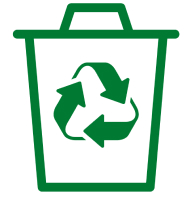Food Waste Recycling is on the Horizon
Interest in recycling food waste is growing. Generators both large and small are starting to develop plans for separating and transporting food scraps while looking for a recycling facility to accept the food waste. Haulers are being asked how they can move food waste economically. Local solid waste managers are calculating whether or not they can provide a facility to process food waste on a sustainable basis.
Food waste recycling initiatives are targeting what is estimated to be 20%-30% of the total solid waste stream. Planning must consider that the volume and character of food waste is quite variable and dependent on whether it is generated in a residential area or in a business, industry or institution. Most managers are traveling into uncharted territory within their regions with regard to food waste. Initial investigations are finding that it is critical to determine how food waste is generated, what volumes are being generated by various sectors, how seasonal changes impact volume, what is contained in the food waste, how it can be collected and transported, and the degree to which contamination may impact the feasibility.
All this was evident within a recent webinar that was sponsored by the New York State’s Department of Environmental Conservation [DEC] and the Pollution Prevention Institute [NYS P2I]. They presented the requirements of the State Food Scraps Recycling Law for New York [ECL Section 27-2003] which will be effective on January 1, 2022. The law will require large food waste generators to 1) donate leftover food if possible, and 2) separate and deliver food waste to an organics recycler as long as there is one within 25 miles of the point of generation. Information is available from DEC including applicability [for example hospitals, nursing homes and schools are exempt], the metrics for businesses to determine if they are covered by the law, the criteria DEC intends for exclusions, and the process for generators to seek a waiver.
B&L offices in New York, Pennsylvania, and Maryland are working with clients on several different approaches to recover and process food waste in accordance with local regulatory guidelines. On the simpler end of the spectrum, we are working on projects that will combine source separated green waste with food scraps in aerated compost operations. This will produce material that can be used in a number of agricultural and horticultural operations. On the more advanced end of technology, we helped a client evaluate the feasibility of co-processing food waste with wastewater treatment plant solids in an anaerobic digester. That project moved forward to include an addition on an existing materials recovery facility/MSW transfer station complex which now receives and processes food waste, removes contaminants, and conveys the material to a large scale anaerobic digester at the adjacent wastewater treatment plant [WWTP]. The food waste operation is up and running successfully and is producing electricity from the digestion process. There are a number of digesters at local wastewater treatment facilities that may have the capacity to take food waste. This facility may be a “model” for other communities that have WWTP anaerobic digesters with available capacity. In addition to the example above, B&L is also working with clients on individual food waste processing and anaerobic digestion facilities in the Mid-Atlantic area. In all cases, B&L provides our clients with information on potential sources of funding for food waste recycling projects.
B&L is ready to assist communities looking to match programs and facilities with their unique needs. Please feel free to contact B&L Senior Project Manager Hans Arnold or Vice President, Sean Sweeney, P.E. if you have an interest in pursuing a program to divert, recover, and utilize food wastes generated in your community.

This article is from members of the Solid Waste Practice Area.
Learn More

